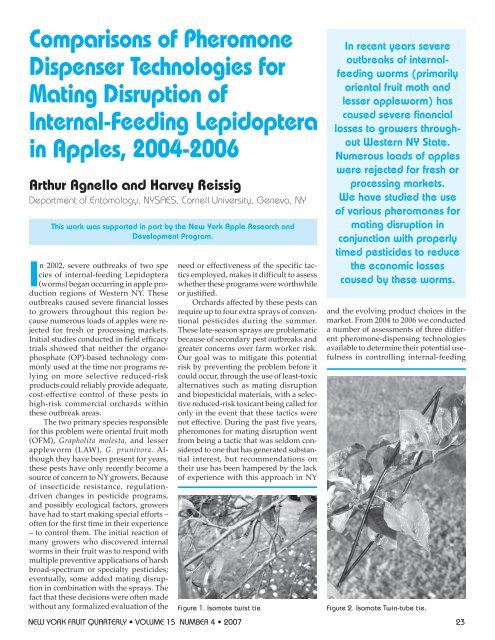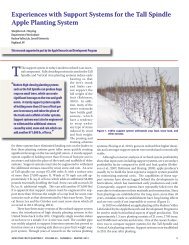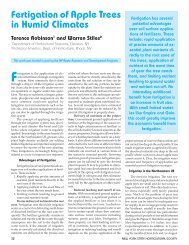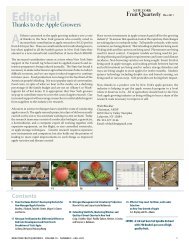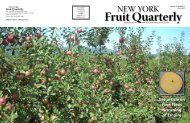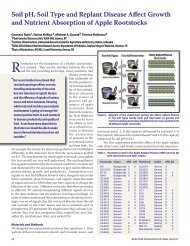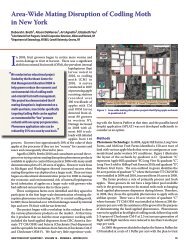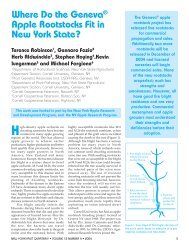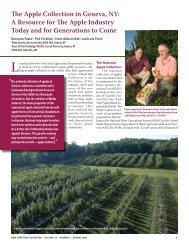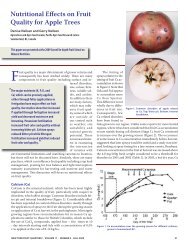Pheromone Dispensers for Mating Disruption of Internal Lep's
Pheromone Dispensers for Mating Disruption of Internal Lep's
Pheromone Dispensers for Mating Disruption of Internal Lep's
Create successful ePaper yourself
Turn your PDF publications into a flip-book with our unique Google optimized e-Paper software.
Comparisons <strong>of</strong> <strong>Pheromone</strong>Dispenser Technologies <strong>for</strong><strong>Mating</strong> <strong>Disruption</strong> <strong>of</strong><strong>Internal</strong>-Feeding Lepidopterain Apples, 2004-2006Arthur Agnello and Harvey ReissigDepartment <strong>of</strong> Entomology, NYSAES, Cornell University, Geneva, NYThis work was supported in part by the New York Apple Research andDevelopment Program.In 2002, severe outbreaks <strong>of</strong> two species <strong>of</strong> internal-feeding Lepidoptera(worms) began occurring in apple productionregions <strong>of</strong> Western NY. Theseoutbreaks caused severe financial lossesto growers throughout this region becausenumerous loads <strong>of</strong> apples were rejected<strong>for</strong> fresh or processing markets.Initial studies conducted in field efficacytrials showed that neither the organophosphate(OP)-based technology commonlyused at the time nor programs relyingon more selective reduced-riskproducts could reliably provide adequate,cost-effective control <strong>of</strong> these pests inhigh-risk commercial orchards withinthese outbreak areas.The two primary species responsible<strong>for</strong> this problem were oriental fruit moth(OFM), Grapholita molesta, and lesserappleworm (LAW), G. prunivora. Althoughthey have been present <strong>for</strong> years,these pests have only recently become asource <strong>of</strong> concern to NY growers. Because<strong>of</strong> insecticide resistance, regulationdrivenchanges in pesticide programs,and possibly ecological factors, growershave had to start making special ef<strong>for</strong>ts –<strong>of</strong>ten <strong>for</strong> the first time in their experience– to control them. The initial reaction <strong>of</strong>many growers who discovered internalworms in their fruit was to respond withmultiple preventive applications <strong>of</strong> harshbroad-spectrum or specialty pesticides;eventually, some added mating disruptionin combination with the sprays. Thefact that these decisions were <strong>of</strong>ten madewithout any <strong>for</strong>malized evaluation <strong>of</strong> theneed or effectiveness <strong>of</strong> the specific tacticsemployed, makes it difficult to assesswhether these programs were worthwhileor justified.Orchards affected by these pests canrequire up to four extra sprays <strong>of</strong> conventionalpesticides during the summer.These late-season sprays are problematicbecause <strong>of</strong> secondary pest outbreaks andgreater concerns over farm worker risk.Our goal was to mitigate this potentialrisk by preventing the problem be<strong>for</strong>e itcould occur, through the use <strong>of</strong> least-toxicalternatives such as mating disruptionand biopesticidal materials, with a selectivereduced-risk toxicant being called <strong>for</strong>only in the event that these tactics werenot effective. During the past five years,pheromones <strong>for</strong> mating disruption wentfrom being a tactic that was seldom consideredto one that has generated substantialinterest, but recommendations ontheir use has been hampered by the lack<strong>of</strong> experience with this approach in NYFigure 1. Isomate twist tieIn recent years severeoutbreaks <strong>of</strong> internalfeedingworms (primarilyoriental fruit moth andlesser appleworm) hascaused severe financiallosses to growers throughoutWestern NY State.Numerous loads <strong>of</strong> appleswere rejected <strong>for</strong> fresh orprocessing markets.We have studied the use<strong>of</strong> various pheromones <strong>for</strong>mating disruption inconjunction with properlytimed pesticides to reducethe economic lossescaused by these worms.and the evolving product choices in themarket. From 2004 to 2006 we conducteda number <strong>of</strong> assessments <strong>of</strong> three differentpheromone-dispensing technologiesavailable to determine their potential usefulnessin controlling internal-feedingFigure 2. Isomate Twin-tube tie.NEW YORK FRUIT QUARTERLY • VOLUME 15 NUMBER 4 • 2007 23
Figure 6. Application <strong>of</strong> Hercon Micro-Flakes using an ATV-mountedmodified leaf-blower.Figure 7. Hercon Micro-Flakes stuck to apple foliage(Figure 5) impregnated with OFM pheromone(7.83 : 0.51 : 0.08% Z:E8-12:OAc :Z8-12:OH), applied at a rate <strong>of</strong> 19.2 g a.i.per acre, or 8 oz <strong>of</strong> flakes per acre. Applicationswere made using a modified leafblower (Arena Turbo-Tac) mounted on anATV traveling at 6–7 mph down the rows(Figure 6). The flakes were stuck to thetree foliage (Figure 7) using an acrylicsticker (Micro-Tac) applied as they wereblown from the machine. The HerconFlake treatments were applied at foursites between 7–8 July in 2005, and at threesites between 29 June–14 July in 2006.Attempts to apply this treatment at threeadditional sites in 2006 were preventedby equipment malfunction caused byjams in the hopper feeder mechanism andsticker blockages in the flake auger.<strong>Pheromone</strong> treatment efficacy in depressingadult male trap catch was monitoredwith pheromone traps in each disruptedplot as well as in a nondisruptedcomparison planting on the same farm orin the same general area. <strong>Pheromone</strong>traps were checked weekly starting be<strong>for</strong>edeployment <strong>of</strong> the mating disruptiontreatments until shortly be<strong>for</strong>e harvest.Although OFM adult catches were monitoredall three years, LAW trap data wastaken only in 2005 and 2006. Becausepheromone mating disruption was notanticipated to be effective enough toeliminate the need <strong>for</strong> all additional insecticidesprays, a fruit sampling procedurewas used to assess the need and timing<strong>for</strong> specific pesticide sprays directedagainst the 2nd and subsequent generations<strong>of</strong> these species. The fruit samplingMean total moths per trap (MD)12108642OFM <strong>Pheromone</strong> vs. Non-MD PlotsIsomateMSTRSHerconMean total moths per trap (MD)54322LAW Catches in <strong>Pheromone</strong> vs. Non-MD PlotsIsomateMSTRSHercon0010100 1000Mean total moths per trap (nondisrupted)00 5 10 15 20 25 30Mean total moths per trap (nondisrupted)Figure 8. Total oriental fruit moths per trap caught during July andAugust in all pheromone treatment plots compared with numberscaught in the respective nondisrupted comparison plots, 2004–2006.Figure 9. Total lesser appleworm moths per trap caught during Julyand August in all pheromone treatment plots compared with numberscaught in the respective nondisrupted comparison plots, 2005–2006.NEW YORK FRUIT QUARTERLY • VOLUME 15 NUMBER 4 • 2007 25
protocol consisted <strong>of</strong> weekly on-tree fruitinspections conducted from mid-Julythrough August, comprising 300 fruits perplot during the first week and 100 fruitsper plot on subsequent weeks, to detectthe initial occurrence <strong>of</strong> any OFM or LAWlarval fruit damage in time to curtail furtherinfestation. Whenever an inspectionsession resulted in detection <strong>of</strong> at least onedamaged fruit, the grower or consultantwas notified so that they could determinewhether a special spray <strong>of</strong> a selective pesticidewas needed <strong>for</strong> adequate control <strong>of</strong>internal Lepidoptera. An evaluation wasmade <strong>of</strong> larval fruit-feeding damage atharvest by examining fruit samples fromeach pheromone plot <strong>for</strong> internal and surfaceinjury. When possible, comparisonswere made with fruit from nondisruptedplantings in most, but not all cases, <strong>for</strong>the 2005 and 2006 trials.Results<strong>Pheromone</strong> Deployment. As ease <strong>of</strong>use and labor requirements are considerationsin deciding the type <strong>of</strong> pheromonedispenser to be used in a particularsituation, data were taken on the timeand number <strong>of</strong> people required to deploythe pheromone dispensers in each plot.In 2004, the MSTRS product required between7.1–12.0 min <strong>for</strong> one individual toapply one acre. Time measurements <strong>for</strong>hand-applied deployment <strong>of</strong> the twist-tieOFM dispensers averaged approximately240 ties/hr/person, or 25 min per acre<strong>for</strong> the Isomate M-100, and 50 min peracre <strong>for</strong> Isomate Rosso. The MSTRS timerequirements correspond to a ~50–70%reduction over the M-100 ties, and ~75–85% over the Rosso ties. Records werealso kept in 2006 <strong>of</strong> the amount <strong>of</strong> timerequired <strong>for</strong> application <strong>of</strong> each type <strong>of</strong>pheromone dispenser, and althoughthere was some variability due to differencesin the orchards’ physical characteristicsand treatment combinations, thefollowing average times were determined:Isomate-M, 37 min/acre/person;Isomate CM/OFM, 34 min/acre/person;MSTRS, 14 min/acre/person; Hercon, 5min/acre (one person driving, but a secondwas needed to assist, and setup timerequired was considerable).Trap Catches. 2004. <strong>Pheromone</strong> trapcatches <strong>of</strong> OFM adult males in the testsites were lower than they might normallyhave been, owing to unfavorablecool and rainy weather during July andAugust. Nevertheless, sufficient numbers<strong>of</strong> moths were caught in the non-disruptedcomparison plots to indicate thedegree <strong>of</strong> effectiveness <strong>of</strong> the pheromonetreatments in the adjacent plantings. Boththe Isomate M-100 and Rosso treatmentscompletely suppressed OFM trap catchesin their respective plots <strong>for</strong> the duration<strong>of</strong> the study; in four <strong>of</strong> the six sites, trapsin the MSTRS plots caught 1-2 moths onone or two occasions.2005. Trap catches <strong>of</strong> OFM and LAWwere generally suppressed to low levelsin all pheromone treatment plots duringthe mid- and late summer, although somebreakthrough captures did occur. Thustrap shutdown was not absolute in allcases. Two plots with notable OFMcatches were the MSTRS and Hercontreatments at the Newfane site. Theseplots were located near a non-disruptedorganic apple planting with a high OFMpopulation, so it is possible that immigrationfrom that block was too severe tobe completely disrupted by the pheromonetreatments in our plots.2006. Oriental fruit moth pressurewas considerable at the Williamson,Newfield, and Kendall sites, but all treatmentsshowed low trap numbersthroughout the season; likewise, lesserappleworm was very numerous atRidgeway, Gaines, Williamson, Newfield,and Kendall, but the respective OFMpheromone treatments effectively depressedthese trap numbers as well.As a means <strong>of</strong> assessing the relativeability <strong>of</strong> the three pheromone treatmentsto disrupt the chemical communicationbetween male and female moths over thecourse <strong>of</strong> all the trials conducted at these20 sites over a three-year period, the totalnumber <strong>of</strong> moths per trap caught ineach <strong>of</strong> the pheromone plots during thedisruption period (2nd and subsequentgenerations) was compared against thenumber caught over the same period ina nondisrupted planting nearby. This wasdone <strong>for</strong> both oriental fruit moth (Figure8) and lesser appleworm (Figure 9). Whileall <strong>of</strong> the pheromone products exhibitedsubstantial activity in depressing trapcatches, a plot <strong>of</strong> the comparisonsshowed that the Isomate ties, in general,tended to be the most effective <strong>of</strong> thethree dispeners, and the Hercon flakeswere less effective, particularly as populationpressure increased. It must be acknowledgedthat both the MSTRS andHercon products were still in the developmentalprocess, and their per<strong>for</strong>mancewas likely impacted by some factors yetto be both addressed and improved uponby the manufacturers.Fruit Damage. In no case did thegrower rely exclusively on mating disruptionto prevent fruit damage by internalfeedinglarvae, so it is not possible to assessthe treatments’ efficacy as a sole tacticin managing these pests. Nevertheless,these trials did af<strong>for</strong>d an opportunity toevaluate each pheromone treatment’srelative management value when used incombination with the grower’s normal insecticideprogram, and in many cases ascompared with that program without theuse <strong>of</strong> pheromones (Table 1).Our notifications to the growers <strong>of</strong>finding fruit damage during the in-seasonfruit inspections did not always resultin a decision to apply an extra spray<strong>for</strong> internal worm control. In 2005, the twosuch occasions at the Yates site happenedto correspond with the grower’s scheduledapplications <strong>of</strong> materials againstother pests that also had some activityagainst OFM. The Alton orchard, whichwas an organic block with a history <strong>of</strong>severe internal worm pressure, was on apreventive schedule <strong>of</strong> presumably themost effective organically acceptable materialsavailable against internal worms(B.t., codling moth virus, and kaolin clay),so the grower was not relying on our reports<strong>for</strong> his spray decisions. At theNewfane site, a spray was applied <strong>for</strong> internalworms in all the pheromone plotsbecause <strong>of</strong> the grower’s concern about theorchard’s proximity to nondisruptedmoth populations, even though damagehad been found in only one treatmentduring one inspection. In 2006, incidence<strong>of</strong> in-season fruit injury was extremelylow except at Newfield, Williamson, andGaines, each <strong>of</strong> which required two notifications<strong>of</strong> damage to the grower or theirconsultant. In contrast to the previousyear, these farms, as well as Ridgeway(one notification), did receive 1-2 directedapplications <strong>of</strong> a selective insecticideagainst encroaching larval populations asa result.Fruit damage caused by internalfeedingLepidoptera at harvest was verylow in all the 2005 treatments at three <strong>of</strong>the five pheromone-disruption sites(Table 1). At the Newfane site, the Isomateplot sustained approximately 10% fruitdamage, although its proximity to anondisrupted organic planting with ahigh population could have been a contributingfactor. Additionally, an unanticipatedlarge codling moth population occurredthat was not being disrupted, sodamage from this species was likely includedin the harvest evaluation, as noef<strong>for</strong>t was made to distinguish betweenOFM and CM damage. The Alton organicsite had previously suffered relatively
TABLE 1Percent deep (internal) and sting (surface) fruit injury 1 at harvest in pheromone-treated and nondisrupted grower standard plots, 2005-2006.Site Treatment Sting Deep Total Site Treatment Sting Deep Total2005 2006Newfane Isomate 0.3 b 9.3 b 9.6 b Ridgeway Isomate 0 a 0.1 a 0.1 aMSTRS 0.1 ab 2.0 a 2.1 a MSTRS 0.1 a 0.4 a 0.5 abHercon 0 a 1.0 a 1.0 a Hercon 0.1 a 0.3 a 0.4 abGrower Std 0.1 a 0.6 a 0.7 bYates Isomate 0.1 a 0.1 a 0.2 bMSTRS 0.2 a 1.6 b 1.8 ab Williamson Isomate 0.1 a 2.8 a 2.9 aHercon 0.1 a 0.6 a 0.7 b MSTRS 0 a 1.8 a 1.8 abGrower Std 0.2 a 1.6 b 1.8 a Grower Std 0 a 0.1b 0.1 cLake Isomate 0 a 0 a 0 a Lake Isomate 0 a 0 a 0 aMSTRS 0 a 0 a 0 a MSTRS 0 a 0 a 0 aHercon 0 a 0 a 0 a Grower Std 0 a 0 a 0 aGrower Std 0 a 0 a 0 aGaines Isomate 0.1 a 0.3 a 0.4 aRidge Isomate 0 a 0.1 a 0.1 a Grower Std 0.3 a 0.4 a 0.7 aMSTRS 0.1 a 0.1 a 0.2 aHercon 0 a 0 a 0 a Sodus Isomate 0 a 0.2 a 0.2 aMSTRS 0 a 0.1 a 0.1 aAlton Isomate 0.6 a 7.2 a 7.8 a Hercon 0 a 0.1 a 0.1 aMSTRS-1 2.1 a 15.6 b 17.7 b Grower Std 0 a 0 a 0 aMSTRS-2 0.9 a 6.0 a 6.9 aNewfield Isomate 0.1 a 0.3 a 0.4 aHercon 0.1 a 2.7b 2.8 bGrower Std 0.2 a 4.0b 4.2 bOlcott Isomate 0 a 0 a 0 aMSTRS 0 a 0.0 a 0 aGrower Std 0 a 0.2 a 0.2 aWolcott Isomate 0 a 0 a 0 aMSTRS 0 a 0 a 0 aGrower Std 0.1 a 0 a 0.1 aKendall Isomate 0 a 0 a 0 aMSTRS 0 a 0.1 a 0.1 aGrower Std 0 a 0 a 0 a1Within a site, values in the same column followed by the same letter are not significantly different at P=0.05 level (Fisher’s protected lsd test).high fruit damage the previous season.Damage in all the treatments here rangedfrom 7–17% damage, which the growerindicated was relatively acceptable <strong>for</strong> theorganic processing market, and a measurableimprovement over the previous season.In 2006, fruit damage at harvest wasvery low in all treatments, and at six <strong>of</strong>the nine sites there was no statistical differencebetween the pheromone plots andthe respective Grower Standards (Table1). Only two <strong>of</strong> the nine sites, Ridgewayand Newfield, had significantly less fruitdamage in one <strong>of</strong> the pheromone plots—Isomate, in both cases—than in the nondisruptedGrower Standard, and at onesite, Williamson, fruit damage was actuallyhigher in the pheromone treatmentsthan in the Standard. In this case, proximityto a large bin storage area (that mayhave been a source <strong>of</strong> uncontrolled moths)was undoubtedly a contributing factor.This was likely a situation where the use<strong>of</strong> farm-wide mating disruption wouldhave been a potential solution.AssessmentAlthough the pheromone treatmentstested were generally a useful component<strong>of</strong> the OFM and LAW management programsin these orchards, some factors canbe identified that potentially contributedto less-than-optimal management: plotsize was not large enough to overcomethe possibility <strong>of</strong> immigration by matedfemales; moth population pressure wassometimes too high to be effectively disruptedby the pheromone treatments; thepheromones were mostly applied againstonly the 2nd and subsequent generations,leaving the potential <strong>for</strong> damage from the1st generation. The in-season fruit inspectionregimen appears to be effective andreliable, but it is difficult to convincegrowers to wait <strong>for</strong> evidence <strong>of</strong> even a lowlevel <strong>of</strong> damage in their orchards be<strong>for</strong>eapplying a special spray against thesepests. Pesticide use against these speciescould be reduced in situations <strong>of</strong> low tomoderate population pressure, wheremating disruption could be relied uponto adequately mitigate potential fruit infestations.In general, considering the overalllevels <strong>of</strong> pest pressure occurring in some<strong>of</strong> these orchards, and the economics (consideringboth materials and labor) <strong>of</strong>implementing these pheromone treatments,it is possible that internal wormproblems in many NY orchards could beadequately addressed by adjusting pesticidespray schedules, improving spraycoverage, or by using selective products<strong>for</strong> a limited number <strong>of</strong> designatedsprays. In 2006 and 2007, we have seenevidence <strong>of</strong> the increasing importance <strong>of</strong>codling moth as a contributor to internalfruit-feeding damage in a number <strong>of</strong>Western NY orchards. This certainly complicatesthe management requirementsNEW YORK FRUIT QUARTERLY • VOLUME 15 NUMBER 4 • 2007 27
<strong>for</strong> this pest group, and any decision to use matingdisruption as a supplemental tactic will needto take this additional species into account. Althoughthese tactics represent a substantial increasedcost in a crop protectant program, theymay be necessary <strong>for</strong> avoiding the higher price<strong>of</strong> having even a single load rejected by the fruitbuyer. Ongoing work in this area will be directedat optimizing more farm-wide managementstrategies, in order to improve the effectiveness<strong>of</strong> both mating disruption and selective insecticideuse and to diminish the potential <strong>for</strong> immigratingmoths to overcome more localized controlprograms.AcknowledgmentsThanks are due to D. Bartleson, B. Beckens,J. Bittner, D. Datthyn, R. DeBadts, R. Endres, C.Hance, D. Hartley, R. Farrow, T. Furber, O. Kalir,T. Kappus, S. Knapp, D. Oakes, G. Pepe, K. Trammel,and M. Zingler, <strong>for</strong> allowing these trials tobe conducted on their farms; to M. Burlee, J. Eve,J. Misiti, and R. Paddock <strong>for</strong> coordinating thesetup and maintenance <strong>of</strong> the plots and communicationswith the growers; to D. Combs, R.Falkey, N. Gottschall, D.A. and D.M. Mitchell,R. Mussack, M. Tapscott, and J. Watt <strong>for</strong> fieldassistance in plot establishment and data collection,and to T. Baker, J. Meneley (AgBio, Inc.), P.Owens (Hercon Environmental), and G. Stamm(CBC America) <strong>for</strong> their cooperation in providingand helping to apply the pheromone products.This work was partially funded by grantsfrom the NY Apple Research and DevelopmentProgram, Motts (Cadbury Schweppes), the NYSIPM Program, the IR-4 Biopesticides Program,and Hatch Federal Formula Funds.Art Agnello is a research and extension pr<strong>of</strong>essor inthe Department <strong>of</strong> Entomology who leads Cornell’sextension program in fruit entomology. HarveyReissig is a research pr<strong>of</strong>essor in the Department <strong>of</strong>Entomology and leads Cornell’s Pest ManagementEducation Program.


